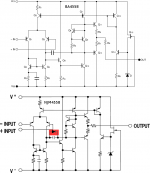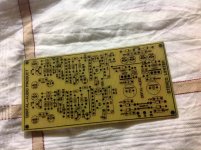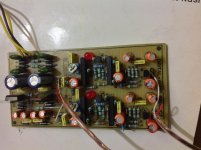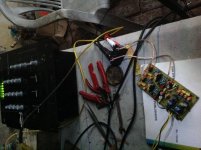You must test by measurement when swapping opamps. Stability is one such test, and how the opamp stage handles a fast squarewave another. Its quite possible to have an amplifier (opamp, discrete, power amp etc) that handles a sine wave seemingly perfectly and yet has major issues with squarewave testing.
http://www.diyaudio.com/forums/anal...u-have-checked-see-its-stable-havent-you.html
and as an idea what squarewave testing shows,
http://www.diyaudio.com/forums/analog-line-level/196461-different-opamp-compensation-technique.html
http://www.diyaudio.com/forums/anal...u-have-checked-see-its-stable-havent-you.html
and as an idea what squarewave testing shows,
http://www.diyaudio.com/forums/analog-line-level/196461-different-opamp-compensation-technique.html
You must test by measurement when swapping opamps. Stability is one such test, and how the opamp stage handles a fast squarewave another. Its quite possible to have an amplifier (opamp, discrete, power amp etc) that handles a sine wave seemingly perfectly and yet has major issues with squarewave testing.
http://www.diyaudio.com/forums/anal...u-have-checked-see-its-stable-havent-you.html
and as an idea what squarewave testing shows,
http://www.diyaudio.com/forums/analog-line-level/196461-different-opamp-compensation-technique.html
Thank you for the links and valid information, but I think most of the internet inserts op-amp's blindly into their equipment and typically arrive at the same conclusions in sound quality and tonal colour.
At times, they'll say "the IC was really hot!", so they'll pull it out.
Not everyone has measuring equipment, I still tell 'the internet' to blindly insert the best op-amp's.
If they didn't, how will they ever experience the amazingly better sound?
Many do just swap devices its true, but its not really the way to go about it as I hope the first post demonstrates.
Many do just swap devices its true, but its not really the way to go about it as I hope the first post demonstrates.
I once inserted an op-amp back-to-front and lots of smoke started coming out of my DAC.
You must test by measurement when swapping opamps. Stability is one such test, and how the opamp stage handles a fast squarewave another. Its quite possible to have an amplifier (opamp, discrete, power amp etc) that handles a sine wave seemingly perfectly and yet has major issues with squarewave testing.
http://www.diyaudio.com/forums/anal...u-have-checked-see-its-stable-havent-you.html
and as an idea what squarewave testing shows,
http://www.diyaudio.com/forums/analog-line-level/196461-different-opamp-compensation-technique.html
I joined the forum after the second link you've provided ended... glad you pointed to it... very useful. It also "proves" that better measurements do not equal better SQ..
Just wanted to report that i did finally measure all opamps in my Buffalo IIIse+Legato line stage DAC on very good friend's equipment and none of those i tried showed any sign of oscillation or any wrong behavior otherwise.
With Buffalo IIIse dac + Legato line stage i measured paired OPA627, OPA827 in adapters as well as LME49860. (The default opamp was LM4562NA). Rest of duals excluded because they can't compete with these mentioned above.
As for final impressions on the sound - the most interesting thing was to test paired single opamps against dual opamps.
So compared to LME49860 which i selected as the best dual in my configuration - the OPA627 perform a little bit faster and cleaner, however it's sound is a bit forward and mid-centric, there's less bass vs mid. Otherwise it sounds as good as expected, i just wish it had a bit more bass (or less mid?)...
On the contrary - OPA827 is more bass-centric and has deep and dark, warm, laid-back sound with impressive soundstage. It even feels somewhat "too dark" sometimes and bass is a bit too much, but it's quite pleasant to listen to. I'm yet to decide on this one...
LME49860 is a very good all arounder. While not better at any specific area than single opamps mentioned - overall sound is very good. It has powerfull bass, good soundstage, detailed highs. It's only drawback is a slight "synthetic" highs of all LM opamps...
With Buffalo IIIse dac + Legato line stage i measured paired OPA627, OPA827 in adapters as well as LME49860. (The default opamp was LM4562NA). Rest of duals excluded because they can't compete with these mentioned above.
As for final impressions on the sound - the most interesting thing was to test paired single opamps against dual opamps.
So compared to LME49860 which i selected as the best dual in my configuration - the OPA627 perform a little bit faster and cleaner, however it's sound is a bit forward and mid-centric, there's less bass vs mid. Otherwise it sounds as good as expected, i just wish it had a bit more bass (or less mid?)...
On the contrary - OPA827 is more bass-centric and has deep and dark, warm, laid-back sound with impressive soundstage. It even feels somewhat "too dark" sometimes and bass is a bit too much, but it's quite pleasant to listen to. I'm yet to decide on this one...
LME49860 is a very good all arounder. While not better at any specific area than single opamps mentioned - overall sound is very good. It has powerfull bass, good soundstage, detailed highs. It's only drawback is a slight "synthetic" highs of all LM opamps...
Last edited:
Excellent I love the LME49860's!!!
TI has a new one I am going to order and try out, the OPA172 or the quad OPA4172.
OPA172 | Precision Amplifier | Operational Amplifier (Op Amp) | Description & parametrics
I don't see a dual version yet.
Cheers!!!
jer 🙂
TI has a new one I am going to order and try out, the OPA172 or the quad OPA4172.
OPA172 | Precision Amplifier | Operational Amplifier (Op Amp) | Description & parametrics
I don't see a dual version yet.
Cheers!!!
jer 🙂
That OPA172 looks dismal for audio due to its incredibly low PSRR (fig10) from the -ve rail (23dB @ 20kHz). However it may be that TI has found another way to measure PSRR as the CMRR plot looks highly respectable and normally CMRR tracks PSRR quite closely. I didn't see any test circuits for how they measured the parameter.
Ya, I know the Slew rate doesn't look all that super, but it does have a low THD and a very low offset drift rate and a decent very low Vos.
jer 🙂
jer 🙂
Kind of ironic that they headline the low input offset voltage spec (200uV) and then promptly trash that with the application circuit they show (LSK489 has 20mV max offset). LSK489 isn't that low noise (1.8nV, so perhaps 10dB better than the opamp) so hardly seems worth it.
But its cheap and cheerful CMOS !
(TI do say it is suitable for high end............. washing machines 😀)
(TI do say it is suitable for high end............. washing machines 😀)
He,he,he,he......Thanks for the input guys !!
Some specs looked good but the rest didn't look so good to me either.
I was hoping that if it does sound good than maybe it could be used in a composite design with a chipamp, else maybe I will just use it for a dc servo or something else non-audio. 😉
jer 🙂
Some specs looked good but the rest didn't look so good to me either.
I was hoping that if it does sound good than maybe it could be used in a composite design with a chipamp, else maybe I will just use it for a dc servo or something else non-audio. 😉
jer 🙂
Hello
greetings NEED to replace BA4558 with better ic to improve distortion and sonic
quality any suggestions please
warm regards
Andrew
greetings NEED to replace BA4558 with better ic to improve distortion and sonic
quality any suggestions please
warm regards
Andrew
Not familiar with BA4458, but an NJM4458 replacement/upgrade can be easily found. https://www.google.com/search?redir...=0#safe=images&hl=en-US&q=njm4558+replacement
Depends on the circuit, the voltage, the available current, etc.
Opa2604, opa2132 or tl072can be subbed if the circuit is suitable.
Depends on the circuit, the voltage, the available current, etc.
Opa2604, opa2132 or tl072can be subbed if the circuit is suitable.
Hello
greetings can anyone tell me the difference between BA4558 and NJM4558 njm ic is
almost 3 times the price of the BA4558
warm regards
andrew lebon
greetings can anyone tell me the difference between BA4558 and NJM4558 njm ic is
almost 3 times the price of the BA4558
warm regards
andrew lebon
They appear to be very similar.
But there is nothing like trying them both. Shouldn't make a difference according to the spec sheet !
But there is nothing like trying them both. Shouldn't make a difference according to the spec sheet !
can anyone tell me the difference between BA4558 and NJM4558
One is made by rohm the other japan radio corp
The main difference I see are the fonts used
you can also look for NEC UPC4558
also might be of interest
Tube Screamer Opamp Comparisons JRC4558D Vs TI RC4558P
One is made by rohm the other japan radio corp
The main difference I see are the fonts used
you can also look for NEC UPC4558
also might be of interest
Tube Screamer Opamp Comparisons JRC4558D Vs TI RC4558P
Attachments
- Home
- Member Areas
- The Lounge
- The Best Sounding DUAL opamps



